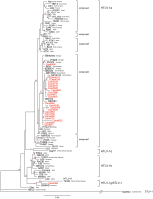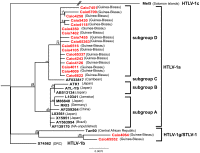Molecular epidemiology of endemic human T-lymphotropic virus type 1 in a rural community in Guinea-Bissau
- PMID: 22720106
- PMCID: PMC3373628
- DOI: 10.1371/journal.pntd.0001690
Molecular epidemiology of endemic human T-lymphotropic virus type 1 in a rural community in Guinea-Bissau
Abstract
Background: Human T-Lymphotropic Virus Type 1 (HTLV-1) infection causes lethal adult T-cell leukemia (ATL) and severely debilitating HTLV-associated myelopathy/tropical spastic paraparesis (HAM/TSP) in up to 5% of infected adults. HTLV-1 is endemic in parts of Africa and the highest prevalence in West Africa (5%) has been reported in Caio, a rural area in the North-West of Guinea-Bissau. It is not known which HTLV-1 variants are present in this community. Sequence data can provide insights in the molecular epidemiology and help to understand the origin and spread of HTLV-1.
Objective: To gain insight into the molecular diversity of HTLV-1 in West Africa.
Methods: HTLV-1 infected individuals were identified in community surveys between 1990-2007. The complete Long Terminal Repeat (LTR) and p24 coding region of HTLV-1 was sequenced from infected subjects. Socio-demographic data were obtained from community census and from interviews performed by fieldworkers. Phylogenetic analyses were performed to characterize the relationship between the Caio HTLV-1 and HTLV-1 from other parts of the world.
Results: LTR and p24 sequences were obtained from 72 individuals (36 LTR, 24 p24 only and 12 both). Consistent with the low evolutionary change of HTLV-1, many of the sequences from unrelated individuals showed 100% nucleotide identity. Most (45 of 46) of the LTR sequences clustered with the Cosmopolitan HTLV-1 subtype 1a, subgroup D (1aD). LTR and p24 sequences from two subjects were divergent and formed a significant cluster with HTLV-1 subtype 1g, and with the most divergent African Simian T-cell Lymphotropic Virus, Tan90.
Conclusions: The Cosmopolitan HTLV-1 1aD predominates in this rural West African community. However, HTLV-1 subtype 1g is also present. This subtype has not been described before in West Africa and may be more widespread than previously thought. These data are in line with the hypothesis that multiple monkey-to-man zoonotic events are contributing to HTLV-1 diversity.
Conflict of interest statement
The authors have declared that no competing interests exist.
Figures


References
-
- Fouchard N, Mahe A, Huerre M, Fraitag S, Valensi F, et al. Cutaneous T cell lymphomas: mycosis fungoides, Sezary syndrome and HTLV-I-associated adult T cell leukemia (ATL) in Mali, West Africa: a clinical, pathological and immunovirological study of 14 cases and a review of the African ATL cases. Leukemia. 1998;12:578–585. - PubMed
-
- Mahe A, Gessain A, Huerre M, Valensi F, Keita S, et al. [Adult T-cell leukemia associated with HTLV-1 in a HIV-2 seropositive African] Leucemie/lymphome T de l'adulte associee au HTLV-I chez un Africain seropositif pour le VIH 2. Ann Dermatol Venereol. 1994;121:704–709. - PubMed
-
- Mahe A, Meertens L, Ly F, Sow PS, Diop CT, et al. Human T-cell leukaemia/lymphoma virus type 1-associated infective dermatitis in Africa: a report of five cases from Senegal. Br J Dermatol. 2004;150:958–965. - PubMed
-
- Hlela C, Shepperd S, Khumalo NP, Taylor GP. The prevalence of human T-cell lymphotropic virus type 1 in the general population is unknown. AIDS Rev. 2009;11:205–214. - PubMed
MeSH terms
Substances
Associated data
- Actions
- Actions
- Actions
- Actions
- Actions
- Actions
- Actions
- Actions
- Actions
- Actions
- Actions
- Actions
- Actions
- Actions
- Actions
- Actions
- Actions
- Actions
- Actions
- Actions
- Actions
- Actions
- Actions
- Actions
- Actions
- Actions
- Actions
- Actions
- Actions
- Actions
- Actions
- Actions
- Actions
- Actions
- Actions
- Actions
- Actions
- Actions
- Actions
- Actions
- Actions
- Actions
- Actions
- Actions
- Actions
- Actions
- Actions
- Actions
- Actions
- Actions
- Actions
- Actions
- Actions
- Actions
- Actions
- Actions
- Actions
- Actions
- Actions
- Actions
- Actions
- Actions
- Actions
- Actions
- Actions
- Actions
- Actions
- Actions
Grants and funding
LinkOut - more resources
Full Text Sources
Miscellaneous

